Efficient fine-tuning of small-parameter large language models for biomedical bilingual multi-task applications
IF 7.2
1区 计算机科学
Q1 COMPUTER SCIENCE, ARTIFICIAL INTELLIGENCE
引用次数: 0
Abstract
The escalating computational costs of large language models (LLMs) have catalyzed the pursuit of more efficient alternatives, particularly in specialized domains like biomedicine. In this study, we propose BioQwen, a series of small-parameter biomedical bilingual (Chinese–English) multi-task models designed to mitigate the resource demands of LLMs while achieving high performance.
BioQwen is trained on carefully curated open-source biomedical datasets, employing a stringent preprocessing pipeline with thorough quality filtering and standardized formatting. Through an efficient two-stage fine-tuning strategy, BioQwen models with 0.5B, 1.5B, and 1.8B parameters attain competitive performance across a variety of comprehension and generative tasks. For comprehension tasks, BioQwen-1.8B achieves a Macro F1 score of 0.730 and a balanced accuracy of 0.802 on the BC5CDR dataset, surpassing the 7B-parameter Taiyi model’s scores of 0.685 and 0.757. In generative tasks, BioQwen delivers superior zero-shot results on the iCliniq dataset, outperforming all baselines across multiple metrics. Comparisons with established small-parameter LLMs (e.g., Llama3.2 1B) further substantiate the effectiveness of domain-specific fine-tuning.
Significantly, BioQwen’s reduced iteration time highlights its computational efficiency, and its quantized version demonstrates successful deployment on mobile devices, confirming its viability in resource-constrained settings. This study demonstrates the potential of strategically fine-tuned small-parameter LLMs to deliver resource-efficient, high-performing solutions for biomedical bilingual applications, expanding accessibility and usability in the field.
生物医学双语多任务应用小参数大语言模型的高效微调
大型语言模型(llm)的计算成本不断上升,促使人们寻求更高效的替代方案,特别是在生物医学等专业领域。在这项研究中,我们提出了BioQwen,这是一系列小参数生物医学双语(中英文)多任务模型,旨在减轻llm的资源需求,同时实现高性能。BioQwen在精心策划的开源生物医学数据集上进行培训,采用严格的预处理管道,具有彻底的质量过滤和标准化格式。通过有效的两阶段微调策略,具有0.5B、1.5B和1.8B参数的BioQwen模型在各种理解和生成任务中获得了具有竞争力的性能。对于理解任务,BioQwen-1.8B在BC5CDR数据集上的Macro F1得分为0.730,平衡精度为0.802,超过了7b参数的Taiyi模型的得分0.685和0.757。在生成任务中,BioQwen在iCliniq数据集上提供了卓越的零射击结果,在多个指标上优于所有基线。与已建立的小参数llm(例如,Llama3.2 1B)的比较进一步证实了特定领域微调的有效性。值得注意的是,BioQwen减少的迭代时间突出了其计算效率,其量化版本证明了其在移动设备上的成功部署,证实了其在资源受限环境下的可行性。这项研究展示了战略性微调的小参数llm的潜力,为生物医学双语应用提供资源高效、高性能的解决方案,扩大了该领域的可访问性和可用性。
本文章由计算机程序翻译,如有差异,请以英文原文为准。
求助全文
约1分钟内获得全文
求助全文
来源期刊

Applied Soft Computing
工程技术-计算机:跨学科应用
CiteScore
15.80
自引率
6.90%
发文量
874
审稿时长
10.9 months
期刊介绍:
Applied Soft Computing is an international journal promoting an integrated view of soft computing to solve real life problems.The focus is to publish the highest quality research in application and convergence of the areas of Fuzzy Logic, Neural Networks, Evolutionary Computing, Rough Sets and other similar techniques to address real world complexities.
Applied Soft Computing is a rolling publication: articles are published as soon as the editor-in-chief has accepted them. Therefore, the web site will continuously be updated with new articles and the publication time will be short.
 求助内容:
求助内容: 应助结果提醒方式:
应助结果提醒方式:


